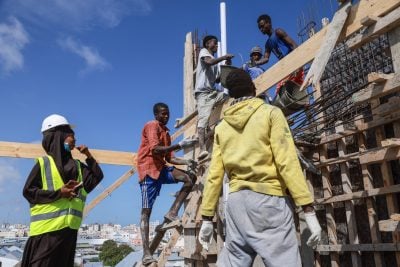This article was produced with the support of IATF
The 2021 Intra-Africa Trade Fair is to take place in Durban, KwaZulu-Natal, South Africa. The Trade Fair itself will take place at the world class Durban Exhibition Centre while the conference will be held at the modern Durban International Convention Centre.
With a population approaching an estimated four million people, Durban, the largest city of KwaZulu-Natal has the second largest economy in the country. The metropolitan area, known as eThekwini, contributes some 16% towards South Africa’s total GDP.
Manufacturing, trade, business services and transport communications are the growth sectors of the province’s economy, together with aluminium conversion, fabricated products, automotive components, electronics, engineering, metal works, petrochemicals and wood products.
In addition, it has a vibrant agriculture sector, with the coastal belts having, for two centuries, been used for growing sugar cane and sub-tropical fruit and vegetables. Forestry and fishing make up other important agri-industrial sectors. Durban itself, boasts of being one the country’s most popular tourist destinations adjacent to its Indian Ocean beach and its proximity to game parks and historical sites.
Further significant sub-sectors include automotive and component manufacture, printing and publishing, food and beverage production, machinery, iron and steel, wood furniture, textiles and clothing. KwaZulu-Natal’s emergence as a hub of industrial development in sub-Saharan Africa may be attributed to a well-developed first-world infrastructure and advantageous coastal location. Economic activity is concentrated mainly in the metropolitan area of Durban, but Pietermaritzburg (the Kwa-Zulu Natal’s administrative capital) and Richards Bay also provide a significant portion of the province’s industrial output.
Richards Bay, and Durban are two of Africa’s primary seaports while the world-class Dube TradePort – home to King Shaka International Airport where many of the IATF participants will be arriving – provides a key competitive advantage and ensure the province’s importance for economic growth.
Special Economic Zones
The province boasts two Special Economic Zones (SEZs), one being the Dube TradePort, close to Durban, and the Richards Bay Industrial Development Zone, in Northern KwaZulu-Natal. The two SEZs are flagship assets for KwaZulu-Natal, attracting a wide range of investments to promote and enhance the competitiveness of the province’s manufacturing sector and to encourage the beneficiation of available resources.
These SEZs have provided opportunities to exporters located throughout the province. This means that businesses do not necessarily have to be adjacent to the province’s seaports or airport to be of benefit. The SEZs have expanded the strategic industrialisation focus to cover diverse regional development needs.
As a long-term, master planned freight and passenger logistics hub, Dube TradePort – located just 30km north of Durban – is rapidly emerging as a vital global supply link and trade centre for KwaZulu-Natal.
The development of Durban’s harbour, one of the world’s major commercial ports, began in 1855. It is now a major container port and point of entry for bulk raw materials, capital goods, and industrial equipment. Minerals, coal, sugar, and grain are exported, and oil is refined and piped to Johannesburg. There is an ambitious $7bn plan to modernise the Port of Durban with the main aim being to improve its efficiency and retain its status as the best-performing port in subSaharan Africa.
Partnerships with private sector
President Cyril Ramaphosa said in April this year that the South African government intends to mobilise private sector participation in the port’s expansion project. This will help the port anchor economic growth and serve as the pre-eminent gateway to southern Africa and the entire continent.
“Partnerships with the private sector are crucial to bring new investment, technology and expertise to port operations and to modernise equipment and infrastructure,” he said in an open letter.
He added that Transnet, the country’s custodian of ports, rail and pipelines, will sign a concession with a private company to build and operate a new terminal in the Point Precinct, which will improve the efficiency of container handling at the port.
The Durban port modernization program will also include the deepening of the Maydon Wharf channel to allow large, modern vessels to enter the port, along with the infill of Pier 1 and Pier 2 to create additional capacity for containers. Once completed, the container handling capacity of the port will increase from 2.9m to 11m twenty-foot equivalent units (TEU containers) each year.
Dealing with congestion
The port of Durban has been grappling with congestion, which has caused shipping companies to express concern about drayage queues, ship berthing delays and anchorage times, along with poor maintenance of equipment and low productivity. Maputo’s rejuvenated port has been competing strongly with Durban.
In 2019, the government formed a multidisciplinary Port of Durban Decongestion Task Team, which came up with measures that are being implemented to tackle the challenge. The measures include synchronising the operating hours of back-of-port container depots with the port’s round the clock operating hours and introducing a holistic truck booking system that provides an integrated view of expected truck volumes in order for all parties to plan more effectively.
“These efforts are already showing results in improved maintenance of equipment, reduced congestion, quicker turnaround times and increased use of rail instead of road transport,” said Ramaphosa. He added that while this is important progress, there is still work that can be done to position Durban as a world-class hub port for the southern hemisphere.
Transnet National Ports Authority data show that the port of Durban overall throughput in 2018 stood at 2.9m TEU, a 10% increase from the 2.6m in 2017. During the same year, total cargo throughput stood at 83.1m tonnes, a 6.4% increase from 78.1m tonnes the previous year.
Register now for the IATF 2021 at https://www.intrafricantradefair.com/en
 Sign in with Google
Sign in with Google 



